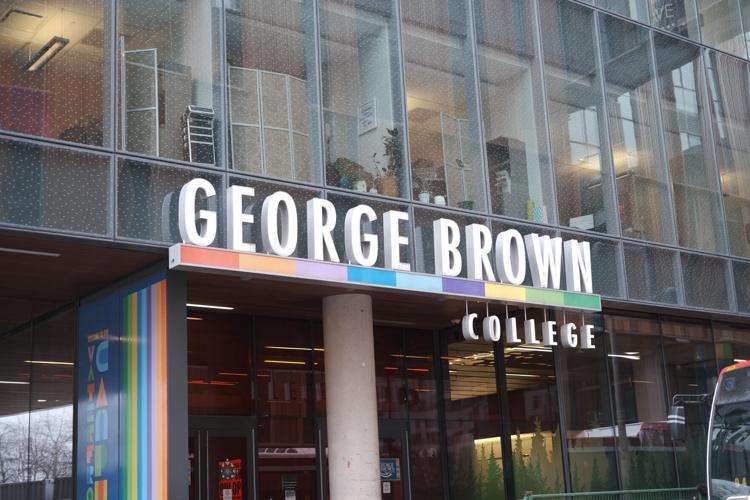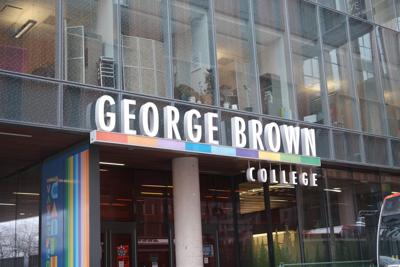A şŁ˝ÇÉçÇřąŮÍřcollege president’s post-retirement payout of at least $1 million has come under scrutiny as Ontario’s post-secondary sector struggles through a fiscal crisis that has resulted in multimillion-dollar deficits, layoffs and cancelled programs.
Anne Sado, who served in the top job at George Brown College for nearly 17 years, , taking on the honorary title “president emeritus.” But she continued to regularly receive compensation that was equal to or higher than her previous annual salary,  earning over $100,000, and above the pay scale of other actively serving presidents.
The expense, raised by staff at a recent George Brown townhall — where the tone set by senior leadership was one of preparing for rough waters ahead — is “gobsmacking,” said Jeff Brown, a professor and chief steward of the local faculty union.
“This is a particularly egregious example of a systemic issue,” said Brown. “What are the priorities? Why are we, as an organization and as a sector, building management ranks rather than investing in what goes on in the actual classrooms?”
Between 2009 and 2019, enrolment at George Brown increased by 41 per cent to 31,328 full-time students. During that period, the (from 506 to 561).
A spokesperson for the college told the Star that Sado’s compensation fulfilled legal obligations related to the terms of her employment and that the agreement ended early last year. Sado did not respond to the Star’s queries.
The spokesperson said George Brown believes in “the importance of responsible financial management and of supporting the success of our students and staff.”
Years of government underfunding, escalating costs and a tuition freeze have put Ontario’s post-secondary sector under strain. Federal changes to the rules around international students, including a cap, have driven down enrolment and exacerbated financial pressures.
Schools are facing large deficits, including George Brown, which is projecting a $70 million shortfall. Colleges and universities across Ontario have suspended courses and announced layoffs and retirement incentives.
This wave of bad news has been largely blamed on government measures, but some also question how much institutions themselves are at fault. Critics allege schools have built complex administrative bureaucracies, investing surpluses in costly executive positions and support staff at the expense, they say, of front-line education. Institutions counter that management has had to grow to meet greater regulatory requirements and increasing demands for non-academic services.
Assistant Prof. Eric Lavigne, who has been examining nearly three decades of post-secondary leadership as part of his research at the University of Toronto, says there is a notion that higher education should reflect society’s values, including fairness: “If a university or college goes through suffering, should the people at the top be seen to be suffering a little as well? I think that’s our expectation.
“Symbolically, if administrations want their communities on board for what’s coming next, they should be seen to lead by example … even if it doesn’t save them real money immediately.”
Ghazal Ghahreman, a first-year jewelry arts student, launched a petition and letter-writing campaign in response to Thursday’s announcement that George Brown would suspend new intake this fall for three of its four jewelry and gemmology programs.
Ghahreman isn’t satisfied with the dean’s explanation pointing to low enrolment caused by changes to international student policy.
“If the institution’s true priority is education and student support, why then is there a focus on enriching upper-level staff rather than investing in these one-of-a-kind programs? This sends a clear message to those of us who have dedicated ourselves to this craft (that) profit and hierarchy are prioritized over meaningful academic experiences.”

Anne Sado retired as president of George Brown College in 2021 but continued to receive annual payments totalling more than $1 million as per the terms of her employment.Ěý
Richard Lautens/şŁ˝ÇÉçÇřąŮÍřStar file photoWhile a lack of comprehensive Canadian data on post-secondary staffing makes it hard to definitively conclude whether the kind of  rings true here, there is than full-time academic staff.
Over the past decade, Ontario colleges have added about 1,500 administrators compared to 500 full-time faculty, according to a . Colleges have increasingly relied on temporary or part-time instructors, and during recent bargaining, its union locals have been .
It is not just a college issue: A concluded the growth of senior administration was outpacing enrolment and tuition revenue — although , noting a “specious analysis” that included existing jobs whose titles had changed.
The Ontario Confederation of University Faculty Associations said it has been raising concerns about senior administrative growth and compensation for years. OCUFA president Nigmendra Narain said members have observed a jump in postings for vice-presidents and associate and assistant dean positions, and have reported departments where those at the top outnumber those who teach and research.
A Star analysis of the going back to 2014 reveals the number of people with vice-president or dean in their titles has increased 54 per cent at Ontario colleges (double the rate of enrolment) and 27 per cent at universities (slightly higher than enrolment).
The nature of who fills these executive ranks differs between colleges and universities; colleges tend to have more career administrators, while university positions are usually headed by fixed-term, tenured professors.ĚýBut for both sectors, salaries and benefits tend to be the biggest expense by far.
A broadening of responsibilities including initiatives around diversity, inclusion and equity, a financial imperative to seek community partnerships and fundraising, and a greater expectation from students and families for wraparound support services on everything from mental health to housing have contributed, at least in part, to the growth of non-academic leadership.
Universities are “administering more complex student services than ever before,” said Steve Orsini, president of the Council of Ontario Universities, noting .
“Despite a growing government regulatory and reporting burden adding to administrative costs, universities continue to prioritize student supports to ensure they have the best possible experiences throughout their education and graduate job-ready and resilient,” Orsini said.
A Â sector has suggested there is room to reduce administrative costs by up to 10 per cent.
But Bill Steinburg, spokesperson for the , said on a per-student basis, inflation-adjusted college expenses have been flat over a decade. “Colleges have only increased expenses to the degree needed to serve increasing numbers of students and cover the rising costs of doing business,” he said.
At George Brown, under Sado’s leadership, .Ěý
In Sado’s last 10 years on the job, her annual salary was about $358,700. Following her retirement, her compensation, according to , was $358,699 in 2021 (which included half-year as president); $454,202 in 2022, when she collected more than her successor, Gervan Fearon ($345,335); and $358,699 in 2023. The 2024 Sunshine List is expected to be made public later this month.ĚýÂ
“Emeritus” is usually awarded to a retired or former senior executive in recognition of their contributions. It is rarely paid but may come with on-campus parking and an office.Ěý
George Brown said there are no financial arrangements associated with the president emeritus position. The college did not explain if there were any expectations of duty — although Sado did participate in a last month on the financial crisis roiling through post-secondary.
Last December, the college told the Star it had “maintained a responsible and measured approach to international recruitment,” but had experienced a drop in international enrolment. It has since suspended more than 20 programs.


































To join the conversation set a first and last name in your user profile.
Sign in or register for free to join the Conversation